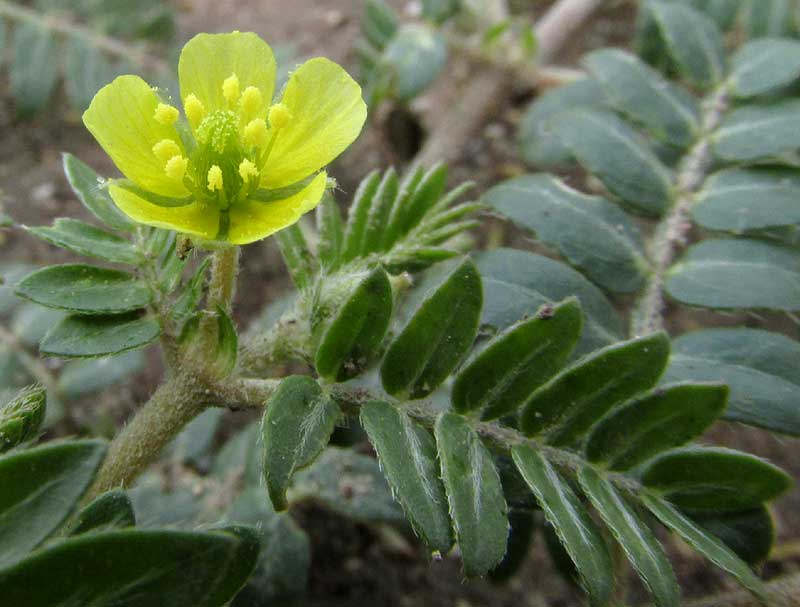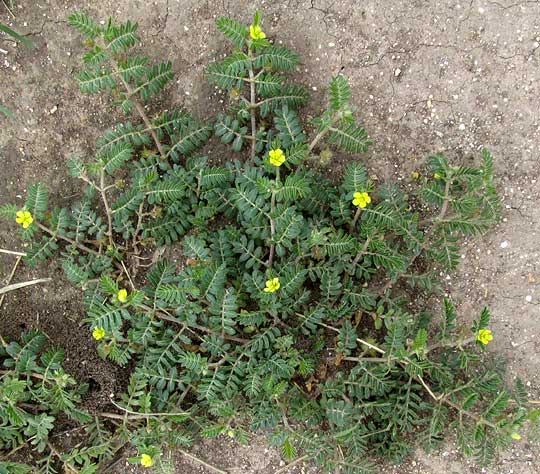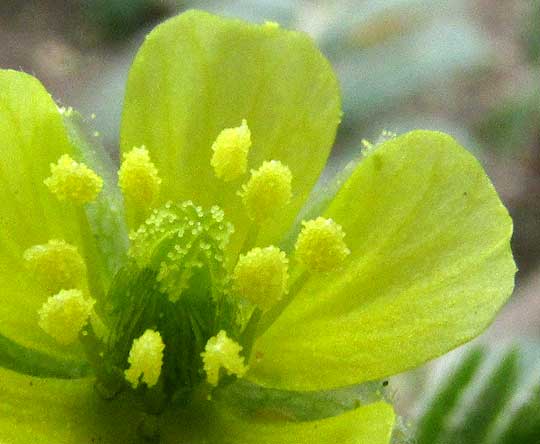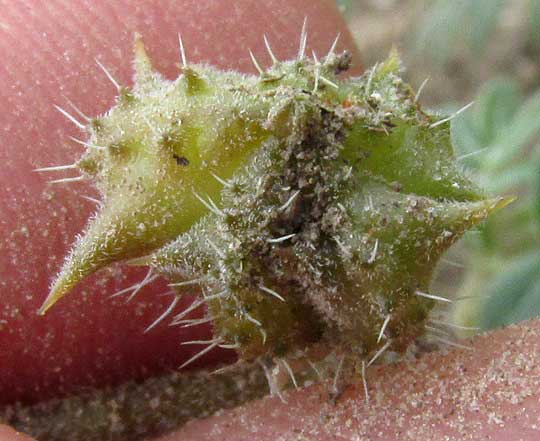Excerpts from Jim Conrad's
Naturalist Newsletter

from the September 28, 2014 Newsletter issued from the Frio Canyon Nature Education Center in the valley of the Dry Frio River in northern Uvalde County, southwestern Texas, on the southern border of the Edwards Plateau; elevation ~1750m (~5750 ft); N29.62°, W99.86°; USA
PUNCTUREVINE
Beneath glaring, skin-sizzling, midday sunlight, on bare, hard-baked dirt washed down from a pond levee at Cook's Slough Nature Park on Uvalde's south side, a ground-hugging little herb was as green and laden with little yellow flowers as if it were a lush, cool spring day. Seeing how other plants couldn't even get a foothold in such a hostile environment, leaving the entire area naked but for this species, you just had to admire the little plant's ability to flourish. Below, you can see a supper-plate-size one:

A portrait of a flower and its attendant pinnately compound leaves appears at the top of this page.
Notice at the bases of the two petioles the erect, narrowly triangular, green stipules. Seeing these in conjunction with the pinnately compound leaves, automatically you think of the big Bean Family. However, the flower is nothing like a bean flower; it's more like a buttercup's blossom. Also, members of the Bean Family only rarely have two leaves per stem node. So, seeing this peculiar combination of flower and leaves, already we know we have something here of a kind we don't ordinarily deal with. A closer look at the flower, showing even more unusual details is below:

Surrounded by the ten stamens, of course the greenish, egg-shaped item is the ovary, or future fruit. That means that the thing looking like a green starfish powdered with pollen grains and clamped atop the ovary must be the stigma. But, have you ever seen such a stigma with arms growing down an ovary's sides like this?
Despite these abnormalities, the moment I saw this plant I knew it, because of painful memories associated with it from back in my days of backpacking in the Mediterranean area. I remember walking along a beach in Spain and deciding to dump the backpack and plop onto the sand to gaze at the sea. I sat down on some of these plants, and that's how I learned the hard way that they produce fruits of the kind shown below:

You can imagine that those things hurt when you sit on them, or walk barefooted through them.
I also remember them from the summer of 2005 when I was exploring California's Sierra Nevadas. My bee-keeping friend Buck brought me the plant asking for an identification because his bees found the plant's yellow blossoms a fantastic nectar source, and he was thinking about getting seeds and planting whole fields of them, even if they did produce such aggravating fruits.
So, the plant is an invasive species from tropical regions of the Old World -- southern Europe, southern Asia, throughout Africa, and Australia -- where it thrives in deserts and poor soil. In the Americas it's spread to everyplace where there's hot, uncharitable soil. Being so widespread, it goes by many English names including Bullhead, Cat's Head, Devil's Eyelashes, Devil's Thorn, Devil's Weed, Goathead, Caltrop, Tackweed, and the one that seems to be popular in the US, Puncturevine, despite it's not being viney at all.
It's TRIBULUS TERRESTRIS, a member of the Caltrop Family, the ZYGOPHYLLACEAE. Maybe the best known native American member of that family is the Creosote Bush, which covers vast portions of the US southwestern desert region. Puncturevine now occurs throughout most of the western US, and is scattered here and there east of the Mississippi.
Beyond producing such an unfriendly fruit, which can even puncture a bicycle tire, Puncturevine's foliage is toxic to livestock, especially sheep, when consumed in quantity. It's not surprising, then, that on both the federal and state level it's listed as a noxious weed, and the Texas Parks & Wildlife Department prohibits its introduction. However, the TexasInvasives.Org website says that "Puncturevine is currently controlled by the stem weevil (Microlarinus lypriformis) and seed weevil (M. lareynii), introduced from Italy as biocontrol agents in 1961."
On the Internet if you do a search on Puncturevine's binomial, Tribulus terrestris, the vast majority of returned links will be to pages that neither refer to the plant's hurtful fruits nor their noxious herbage. They'll claim that extracts of the plant increase the body's natural testosterone levels and thereby improve male sexual performance and help build muscle, and they'll probably try to sell you some tablets. In fact, one study has shown that Puncturevine extracts can indeed alter sexual behavior in castrated rats, apparently by stimulating androgen receptors in the brain.
Before society became so fixated on male sexuality and muscles, the plant was used in traditional medicine as a diuretic (makes you pee), demulcent (forms a soothing film over mucous membranes, relieving minor pains and inflammations), tonic (tones you up), aphrodisiac and laxative.